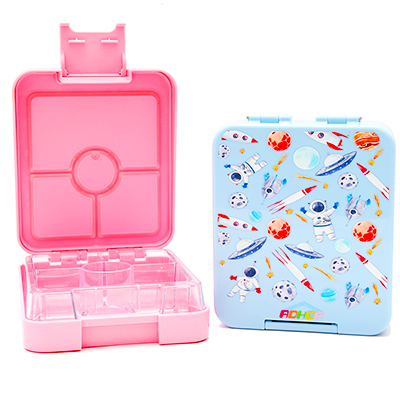For environmentally conscious consumers, the following factors can be considered when choosing a lunch box:
I. Material
Biodegradable materials:
Give preference to lunch boxes made from biodegradable materials, such as plant fibre materials. These materials can decompose relatively quickly in the natural environment, reducing long-term pollution to the environment. For example, lunch boxes made from bamboo fibre or bagasse can be decomposed by microorganisms within a certain period of time after disposal and return to nature.
Understanding the degradation time and conditions of different biodegradable materials ensures that they have a better environmental performance in the actual use environment. Some biodegradable materials may require specific temperature, humidity or microbiological environment for effective degradation. Consumers need to choose the right materials according to their living scenarios and disposal methods.
Recycled materials:
Consider using lunch boxes made from recycled materials, such as recycled plastic or metal. This helps reduce the extraction and consumption of virgin resources while also reducing waste generation. For example, some brands use recycled polypropylene (PP) plastic to make lunchboxes, which, through advanced processing, provides comparable performance to brand-new materials, but with less impact on the environment.
Check the product's recycling logo and description for the percentage and source of recycled content. Some products will clearly label the use of recycled materials. Consumers can choose lunch boxes with a higher percentage of recycled content to support resource recycling to a greater extent.
Durable materials:
Choosing durable materials can extend the life of lunchboxes and reduce the waste of resources caused by frequent replacement. For example, stainless steel lunchboxes are strong, durable and resistant to damage, and can last for many years. In contrast, some inexpensive plastic lunchboxes may be prone to breakage or deformation and require more frequent replacement.
Consider the material's resistance to drops, corrosion and heat. These properties are especially important if the lunchbox needs to be carried frequently or used in different environments. For example, stainless steel and glass lunchboxes are usually more resistant to drops and corrosion, while silicone lunchboxes are heat resistant and can be used in microwave ovens.
Second, functional design aspects
Sealing:
A good seal prevents food leakage and reduces food waste and environmental pollution. Choose a lunch box with a sealing rubber ring or a carabiner design to ensure that food will not spill out during the carrying process. For example, some lunchboxes are designed with double sealing, including a silicone sealing ring on the lid and a snap lock, which can effectively prevent leakage of soup.
Consider the suitability of the sealing performance for different foods, e.g. for liquid foods or foods with strong odour, a higher sealing requirement is needed. You can check the sealing performance of the lunch box by checking the user reviews of the product or conducting actual tests.

Layered design:
Layered design can help distribute food properly, avoid mixing and cascading of flavours between foods, and also help reduce the use of disposable packaging materials. Choose lunchboxes with multiple independent tiers that can hold different food items such as main dishes, side dishes and fruits separately.
Consider the flexibility and adjustability of the layering so that it can be adjusted for different amounts and types of food. Some lunchboxes have tiers that can be removed or adjusted in height to meet different usage needs.
Appropriate capacity:
Choose a lunch box with the right capacity to avoid wasting food or carrying inconvenience due to oversized or undersized lunch boxes. Determine the capacity of your lunchbox according to your eating habits and the amount of food you eat, to ensure that it can satisfy the needs of a lunch without over-packing.
Consider whether the shape and size of the lunch box is easy to carry and store. For example, a rectangular or square lunch box may fit more easily into a backpack or handbag, while a round lunch box may take up more space.
Third, in terms of branding and certification
Eco-friendly brands:
Choose brands that focus on eco-friendly products. These brands usually pay more attention to environmental factors in material selection, production process and product design. You can assess a brand's environmental credibility by checking its official website, learning about its environmental philosophy and practices, and checking reviews from other consumers.
Some eco-friendly brands may participate in environmental certifications or sustainability programmes, such as obtaining the green certification mark or participating in carbon reduction schemes. These certifications can be used as a reference for choosing lunchboxes, demonstrating the brand's efforts and commitment to environmental protection.
Certification Mark:
Check whether the lunchbox has relevant environmental certification marks, such as food contact safety certification and recyclable mark. These marks can prove that the product meets certain standards and requirements in terms of material safety and recyclability. For example, the EU certification mark for food contact materials (e.g. LFGB certification) ensures that the materials used in lunchboxes are not harmful to human health and also meet environmental requirements.
Understand the meaning and authority of different certification marks, and choose a reliable certified